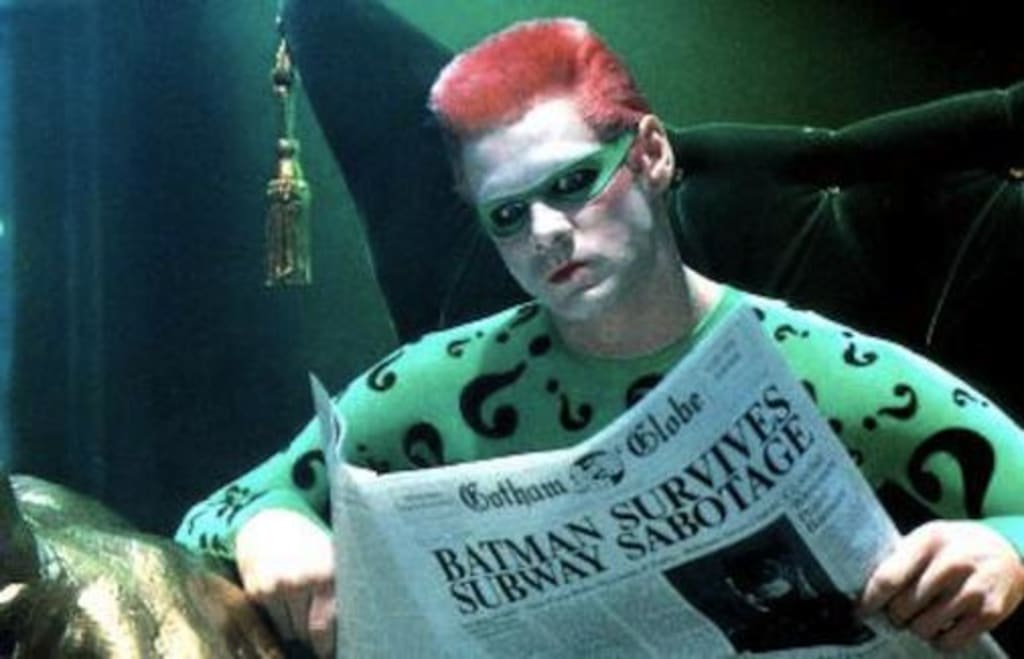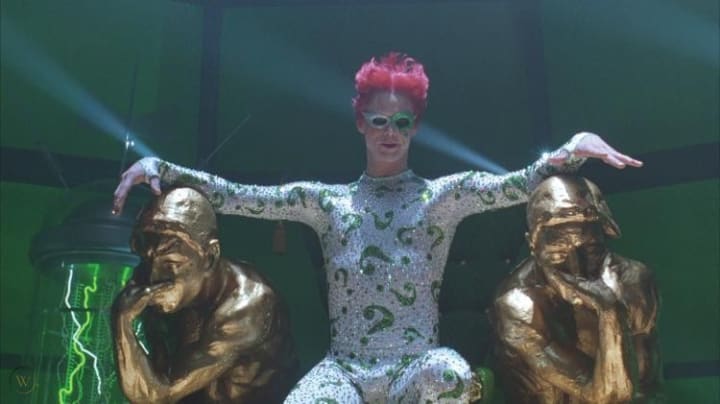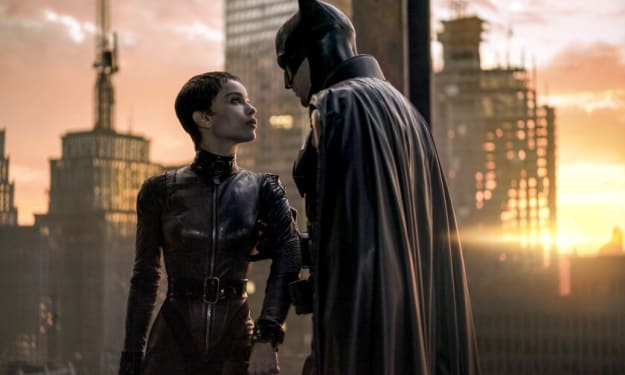
With the release of The Batman, people are prone to compare previous films. One film has a better Batman but a worse Bruce Wayne. Another has a better Penguin but a weaker Catwoman. These are the arguments one will make and or can find. It is hard not to engage in this sentiment. We live in a fan-devoted, overly-competitive, and dare I say, an ideological state. Liking one version of a character to another makes one an enemy/outsider to some fans.
Without comparing, we cannot help but look back though. Assuming you did not watch Tim Burton's Batman anytime soon before July 2008, you went back after viewing The Dark Knight. The Joker was the topic of discussion and interest. Hence, what was he like in 1989? We are not here to discuss who is the better Riddler - Jim Carrey or Paul Dano. No, we are here to look back and see how Jim Carrey as The Riddler holds up on its own. How has the character aged? Is he worth remembering? Can anything be taken to apply to future incarnations of The Riddler?
Setting The Time
Let us go back in time first. Before Batman Forever, Jim Carrey was on top of the world with three comedic hits. Ace Ventura: Pet Detective, The Mask, and Dumb & Dumber opened to great appeal, both critically and financially. These films go on to rake in hundreds of millions of dollars. The rubber-faced, hilarious actor was at his peak. In the span of one year, 1994, audiences see Jim Carrey at quite possibly his best. An entire generation will think of at least one of these films when they hear his name. Nothing Oscar worthy, he has numerous nominations at the time from the Golden Globe Awards, Nickelodeon Kids' Choice Awards, MTV Movie & TV Awards. His inclusion only adds to the pop-culture hype of the new Batman movie in the summer of 1995.

At the time, Batman Forever received a moderately-warm welcome at best. Joel Schumacher's take on Batman brought in a larger box-office gross than Batman Returns. With little to no controversy, toys sold more, and parents and McDonald's were pleased. Later on, fans would dislike the film outright as Schumacher finished with Batman & Robin. At the same time, some will tolerate it as the lesser evil of Schumacher's Batman entries. Take this, adding the appeal of Jim Carrey; no putrid fan-hate exists for his take on Batman's puzzling villain. Unlike Jared Leto's Joker, Tommy Lee Jones' Two-Face, or the entire cast of Batman & Robin, Mr. E. Nygma receives a warm welcome. One reason may also stem from the lack of competition prior to Paul Dano's portrayal. John Glover's voice of The Riddler for Batman: The Animated Series is terrific. Unlike Mark Hamill's Joker, it never met any similar appraisal. Cory Michael Smith has a following building, but mainly from the niche' fandom of Gotham. Hence, this is a generation's Riddler, especially for those who want to forget the campy sixties. This creates a bias and gate-keeping mentality. Nostalgia begins to cloud any objectivity.
Diagnosing The Riddler
Traditionally, The Riddler has a personality trait of narcissism. You can find people in history who send messages to the authorities with these same traits. A person with self-doubt hardly has the steel and muster to send threats to the police. In addition, The Riddler has a compulsion to create riddles. However, he may not view it as a compulsion. Jim Carrey's Riddler does not come off as entirely narcissistic. Instead, Edward Nygma suffers from borderline personality disorder. Already it is surprising that some fans would not call this difference out. Perhaps due to limited knowledge of psychology, fans give this a pass. You can read Dr. Andrea Letamendi's diagnoses of the cinematic Jokers, all differing. When it comes to arguing over who is the more-accurate Joker, this field does not play a role in fans' arguments. We all know something is off with The Joker, purple suit, white make-up, green hair - good enough. We can apply the same for The Riddler - a bit kooky, green costume and tells riddles - works for us. Now, this does not automatically define Jim Carrey's Riddler as bad. I simply ask any comic book purists who defend Jim Carrey's Riddler to take this into consideration.

Let's walk down this path of comic book accuracy no-no's. Never in the film does The Riddler send his riddles to Batman or the authorities. Instead, he leaves these puzzling messages for Bruce Wayne. Recall he does not know that Bruce Wayne is Batman until after the third riddle. Traditionally, the reasoning for these riddles is simply attention to feeding Nigma's ego. If Batman or the authorities fail in solving the riddle, it proves, at least to Nigma, that he is intellectually their superior. Plus, the riddles serve as a clue and challenge to stop the criminal's villainous act. Here, the messages are a clue to The Riddler's identity in stalking his victim. In both versions, the riddle brings attention to this individual, but for different motives. Dr. Travis Langley notes Jim Carrey's character having borderline personality disorder. Langley namedrops a book on the subject - I Hate You--Don't Leave Me. The title alone gives you a simple understanding on these people's psychological make-up. People as such have an even worse time with rejection, and go to extreme lengths to fill an internal void. Of course Nygma will not pick up the telephone to start a healthy dialogue with Mr. Wayne. Neither will he accept this rejection by letting Mr. Wayne be, like most of us would probably do. In both incarnations, there is a power-play in sending these messages, but with Jim Carrey there is a stalker vibe.
Now The Riddler's origin depends on Bruce Wayne, unlike other versions of the villain. Narratively this weakens the antagonist when he cannot exist without the protagonist. This changes the dynamic of The Riddler being fixated, at least, on Batman to Bruce Wayne instead. Plus, this makes the villain one-note. Outside of the film, what happens once Bruce Wayne finds out who is sending these riddles? In addition, what if The Riddler did kill Bruce, as he mourned in the final act of the film? Yet, perhaps this goes back to the differing in psychology of said character. The traditional narcissist is a response to low-witted society. Whereas the borderline personality disordered, stalker is a response to his hero and mentor. In the end, this interpretation of the character can only exist in the confines of a 90 minute plus film.
The Goal and Motivation
What does The Riddler want? Marc Bernardin answers bluntly - "Edward Nygma doesn't really want anything. He wants to know shit about people...who don't matter." This is putting it simply, as there is more to it than that, although convoluted.
At the beginning of our introduction to Edward Nygma he wants to meet his idol, Bruce Wayne, and for him to okay his project. He meets Mr. Wayne, but Mr. Wayne denies the project, for the idea of manipulating brain waves "raises too many questions." Afterward, Nygma begins mailing Bruce these odd riddles that use pictures of Bruce Wayne. Then out of nowhere, he is inspired by Two-Face on the television to become a costumed super-villain. Upon introducing himself to Two-Face, the plan is for the veteran villain to help him finance (through robberies) to produce his idea of The Box.
This device of Nygma's has always been a bit strange. By manipulating the viewers' brainwaves, The Box will make the viewer feel as if they are inside the show. Virtual reality? The film fails to be clear as if Nygma planned to use The Box to make himself smarter, leaving this out from his pitch to Bruce Wayne or a later attachment for plot reasons. He notes of being a god for having all of this knowledge, including but not limited to "credit card numbers, bank codes, sexual fantasies, and little white lies." Hence, he wants to use this intel to become rich, nay, richer, and possibly blackmail people? Perhaps Marc Bernardin's critique is not far off.

Nygma mails Bruce two riddles before he becomes The Riddler. The fourth and final riddle serves as a challenge to Bruce Wayne and Batman. Hence, what was the endgame of sending these messages before becoming The Riddler? What is it about Two-Face that makes Nygma take up costumed villainy? Why could Nygma not take a more legal route to produce The Box? Before watching the circus, Nygma shows no real scheme or goal besides sending Bruce Wayne awkward riddles. None of this is at the fault of the character but the script. Nonetheless, it does belittle the villain.
We see The Riddler wants to be Bruce Wayne, even outclassing him. However, he also wants to kill Bruce Wayne as well. Which is it? Granted, this is common for people with borderline personality disorder. Yet, the film is unlikely aware of this trait and again goes back to just poor screenwriting. The Riddler laments at the end of the film, "Why? Why can't I kill you?" However, before the final act, The Riddler makes no statement or shows any real action in wanting to kill our hero.
The Performance
What needs addressing most importantly is Jim Carrey's performance as The Riddler. LA acting coach Anthony Gilardi sums this up well. We have a man motivated by envy, which makes for a compelling backstory. However, there is no evolution to this point when Nygma is outclassing Bruce. Still, Nygma has insecurity and no confidence in himself, which flies in the face of the traditional comic-book character.
In the party scene, Nygma dons a mole just like Val Kilmer's Bruce Wayne. Bruce begins to argue with him with his glasses on. Edward is quick to put his glasses on as well, and the moment Bruce discards his glasses so does Edward. In these small details, one can see Edward's unhealthy infatuation with Bruce Wayne and wanting to be him. The moment the glasses come off, we are back in Jim Carrey-country. Gilardi even comments, "if you are trying to emulate somebody, then emulate them." Carrey is known for his wide-rubbery-faced expressions, never relaxing a muscle on his face. He cannot tone it down to Val Kilmer's more subdued performance. Every actor has something they are known for and bring to the table. Sometimes, it is okay for an actor to usher in what they can if it suits that character and that role. Imagine cutting several of Carrey's scenes from Batman Forever into another of his movies. Superficially, on a surface level, you could assume both are the same character - Ace Ventura/ Edward Nygma - they both are over-the-top. Instead, the character comes off like a cartoon and lacks humanity.
Kevin Smith notes, "He invokes Gorshin, even though you're not supposed to," and this critique is not wrong. Again, an actor needs to approach their role as an individual bringing what they can, not as 'how would X approach this role?' One cannot liken this to Ben Affleck portraying Superman as George Reeves, for he plays George Reeves, who played Superman. Heath Ledger did not take to The Joker like Jack Nicholson, hence why both are great and stand out so well. The direction does not help to place Jim Carrey's Riddler in an atmosphere similar to Frank Gorshin's Riddler. With neon colors, Dutch tilts, outrageous costumes, and sets, how could one help but not play it like one of the characters/actors from the old television series? Personally, I dare say there was something more menacing and unstable from Frank Gorshin's Riddler.
Interestingly enough, Jim Carrey has shown he does not always have to be animated. First and foremost, he is a comedic actor. We all know and get that. In comedic dramas like The Truman Show and Man on The Moon, Carrey leaves behind the silly antics for some actual humanity. We see him show range in films outside of comedy like the thriller The Number 23, the historical romance The Majestic, and one of his best non-comedic roles in Eternal Sunshine of the Spotless Mind. Of course, these all came after Batman Forever. Maybe Jim Carrey did not see it in himself prior, nor did any director. Something like The Cable Guy, which also came after, could work. Remember The Cable Guy, although a comedy, was a black comedy and something of a psychological thriller. Yes, there is plenty of animated antics, but they come with a sense of uneasiness and disturbance. The stalking from The Riddler comes off more like a spurned teenage lover than the unsettling, creepy stalking of Jim Carrey's character in The Cable Guy.
Conclusion
Fandom operates between the beloved and despised character portrayals. Years later, people are still heaping praise on Jack Nicholson, Heath Ledger, Michelle Pfeiffer, and more. Across the aisle, there is still criticism for Jared Leto, Arnold Schwarzenegger, and others. One will rarely find Jim Carrey's Riddler in either of these talks. Suffice it to say - he left little to no mark on this role and in the history of Batman media. We see Jack Nicholson's Joker inform the Joker of Batman: The Animated Series slightly, especially with the inclusion of the Jack Napier name. Catwoman's origin in the New 52 borrows a piece from Batman Returns. They go on to model Mr. Freeze in LEGO Batman 3: Beyond Gotham off of Arnold Schwarzenegger, with a poor imitation of his Austrian accent. Odd, but all those terrible ice puns in that hokey voice sticks with you, regardless of your feelings on Batman & Robin.
One can see it is recontextualization like Joker being a terrorist in The Dark Knight or a new take on the character like what Paul Dini brought to Mr. Freeze that leaves an impact. Joel Schumacher brings nothing new with Jim Carrey as The Riddler. Let us present you the campy Riddler of before but in the nineties. Yes, he adds the borderline-personality disorder angle but comes off more like a minor detail. This does not transform or evolve the character by any great means. Simultaneously, The Riddler has had trouble in story-telling in being taken seriously. Creatives could not help but fall back on the camp of yesterday. Eventually we got contemporary takes on The Riddler like the hacktivist in Batman: Arkham Origins or the Zodiac-Killer in Matt Reeves' The Batman.
They could have done something like a Hannibal Lecter, minus the cannibalism for the character. Mind you, Silence of The Lambs was four years before Batman Forever. Let's not fault those behind the film too much, for the idea simply was not there. In another context, we cannot fault people in the 19th century for not having 20th century solutions for their problems. Hence, they fall back on what they know. Finally, Batman Forever had to fix the damages of Batman Returns with its dark, somber tone. A Zodiac-Killer running through Gotham, even with neon, was never an option.
Jim, we love you, but this swing is a miss. Luckily, you went on to many successes after your time in Gotham City. We cannot say the same for others who, will not be named after they left Gotham.
About the Creator
Skyler
Full-time worker, history student and an avid comic book nerd.






Comments
There are no comments for this story
Be the first to respond and start the conversation.